
Hokkaido is a foodie's paradise. With everything from fresh seafood to outstanding meat and dairy products, it’s an excellent destination if you want to enjoy a variety of dishes, from seafood and vegetables to meat and dairy products.
Here’s a variety of exquisite Hokkaido food delights that will satisfy both your stomach and your heart. Be sure to try as many as you can during your Hokkaido trip!
- Table of Contents
-
- 1. Seafood you should definitely keep in mind when you come to Hokkaido!
- 2. Delicious sushi and seafood bowls!
- 3. How to eat the most delicious Hokkaido food, Genghis Khan (Jingisukan)
- 4. Taste “Hokkaido’s Three Great Ramen” and “Rishiri Ramen”
- 5. Sapporo soup curry: Compare each store's unique style of soup and ingredients!
- 6. Obihiro's specialty “Pork Donburi”: Visually impactful and appetizing!
- 7. Hokkaido's soul food, “Zangi,” is evolving rapidly
- 8. Enjoy the gentle taste of "Ishikari Nabe"
- 9. Kushiro’s sizeable “Supakatsu”
- 10. Exquisite sweets found only in Hokkaido
1. Seafood you should definitely keep in mind when you come to Hokkaido!

When talking about must-eat Hokkaido food, you have to try the seafood. Hokkaido, surrounded by the Pacific Ocean, the Sea of Japan, and the Sea of Okhotsk, is known for its excellent seafood. Here are some of the seasonal specialties:
Crab (Kani)
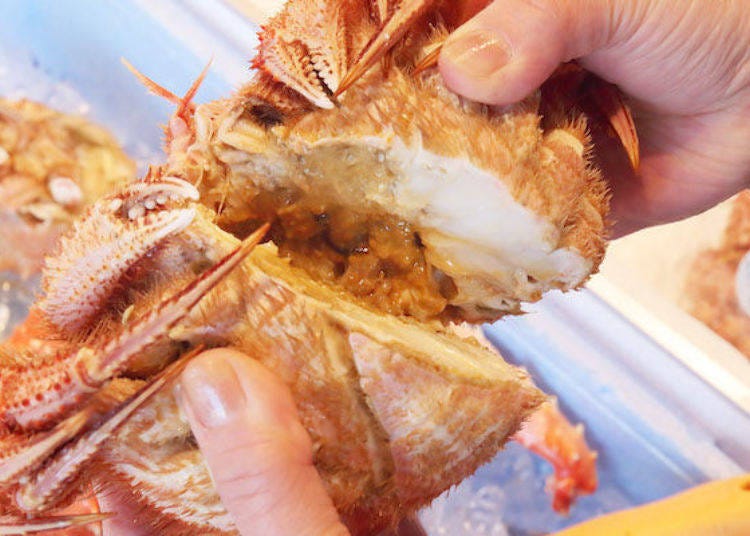
While crab is often associated with winter, this famous Hokkaido food can be caught year-round in the waters near Hokkaido, and the king crab and snow crab are most delicious from April to May after the drift ice has gone. Boasting the best crab in Japan, Hokkaido crab is a must-eat, and you can eat different varieties in each season.

At Katukakino Hanasaki in Sapporo, the full crab course featuring a whole live king crab is popular. Don’t miss the live performance where the manager nicknamed “Crab Father” handles a crab right before you!
Salmon Roe (Ikura)

Ikura (salmon roe) season is from September to November. It’s also the best time for salmon itself. While it’s easily found in cities like Sapporo and Hakodate, it’s also recommended to go to areas with salmon fishing grounds, such as the Ishikari region. The seasoning depends on the restaurant, but this fabulous Hokkaido food is always delicious when served with plenty of hot rice!

At the Hokkaido Robata Igokochi izakaya (pub) in Sapporo, the “Super Famous! Posei-don” includes salmon roe on top of sea urchin, salmon and tuna. The staff will cheer you on while you try to eat this huge bowl of delicious seafood!
Sea Urchin (Uni)

Sea urchins, or uni, are a Hokkaido food that can be caught all over the island throughout the year. But those harvested from June to August – especially from Rishiri, Rebun, and Shakotan – are particularly delicious Hokkaido uni. Sea urchins that have fed on quality kelp will have plenty of umami and melt in your mouth with an irresistibly creamy taste! They also go well with Western dishes such as pasta.

The “Asa Uni Bukkake Donburi” at the Tamura Iwataro Store in the Bikuni area of Shakotan is a popular menu item that allows you to choose your own portion of sea urchin. It’s only available during the sea urchin season, from June to August, with urchins caught the day before they’re served. Only 30 to 50 dishes are sold each day, and they usually sell out, so if you want to try this elusive Hokkaido food, be sure to check on its availability.
Oysters (Kaki)

Oysters come from numerous famous locations throughout Japan, but only Akkeshi in Hokkaido ships them all year round because region maintains the salt concentration and 10 degrees water temperature suitable for oyster growth. In winter, oysters store a lot of glycogen to endure severe cold, giving them a particulary delicious umami flavor. Akkeshi's oysters are also large enough that you’ll feel their weight on your fingertips when lifting them with chopsticks.
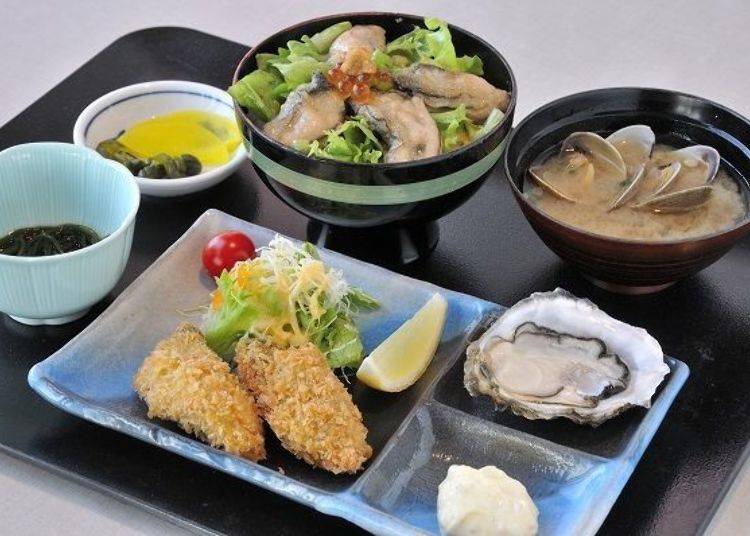
If you want to eat Akkeshi oysters, Conchiglie “Road Station Akkeshi Gourmet Park” is highly recommended. The restaurant serves authentic oyster dishes and features an area where you can grill oysters you’ve just purchased as well as a snack corner with fried oyster burgers and oyster-flavored soft serve ice cream.
Squid (Ika)

For fresh squid, Hakodate is the best place to find it. Squid is in season from July to September is one of the specialties of the Hakodate Morning Market. Squid sashimi in ginger looks great, and has a wonderful texture.
- Japanese
- English
- Kani
- Crab
- Ikura
- Salmon Roe
- Uni
- Sea Urchin
- Kaki
- Oysters
- Ika
- Squid
2. Delicious sushi and seafood bowls!
Hokkaido is a great place for delicious fresh seafood, and many of the local markets, fishing ports, and tourist areas also offer sushi and seafood bowls that are worth trying.
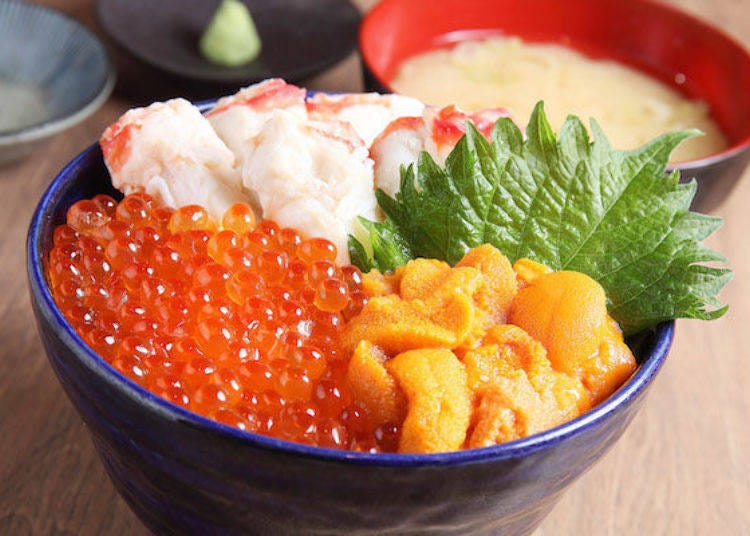
Nijo Market Oiso, a seafood rice bowl specialty store in Nijo Market. Located in the center of Sapporo, it’s full every day. Dishes using sea urchins are especially popular, and they are selected from the top seasonal locations around Hokkaido, such as Hidaka in spring and Higashi in winter. From June to August, the sea urchins come from Rishiri Island and Shakotan.

Washoku to Sushi no Nijo, right next to Nijo Market, is an excellent place to enjoy sushi at a reasonable price. In contrast to the Nijo Market, which is full of tourists, it is characterized by many local regular customers. Menu items include grilled fish, tempura, fried foods, and boiled dishes. The variety of seafood dishes and different methods of preparation are refreshing.

Hakodate Asaichi (Morning Market), which is located near JR Hakodate Station, is home to about 250 shops and is also popular with tourists. One shop, “Kikuyo Shokudo,” is a well-established cafeteria with set meals and seafood bowls. You can enjoy fresh seafood mainly caught in the waters near Hakodate, such as sea urchins kept in salt water with the same concentration as seawater and homemade dishes prepared daily.
3. How to eat the most delicious Hokkaido food, Genghis Khan (Jingisukan)
“Jingisukan” (“Genghis Khan”) is a must-eat Hokkaido food. Nationwide, the seasoned mutton used in the dish is soaked in sauce and then grilled. Hokkaido-style Jingisukan employs a reverse method in which the meat is grilled, then dipped in sauce.
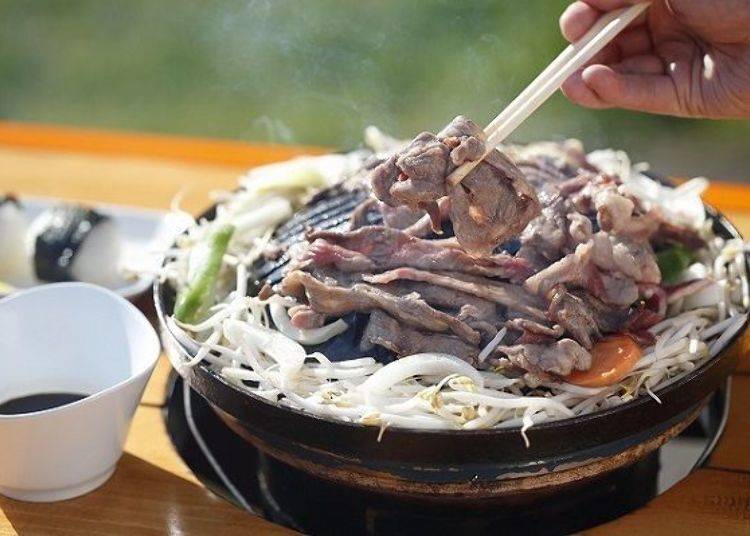
This method is said to be the original way to eat the dish, which has its roots in Manchuria (now Northeastern China) and Saita (now Sakhalin) in the days of Genghis Khan. In the early 20th century, the dish gained popularity in Hokkaido when local residents used sheep that had been bred for wool production as a source of food.


Tsukisapp Jingisukan Club is considered the forerunner of Hokkaido-style Jingisukan and probably not an exaggeration to say it was born there.

The secret of the deliciousness of Jingisukan at Tsukisapp Jingisukan Club is the way in which it’s prepared. Bean sprouts and other vegetables are placed only around the edges of the pan, while the mutton rests directly in the middle of the pan. By arranging the ingredients this way, excess grease from the meat flows down the grooves in the pot, giving the vegetables a distinct flavor.

When the mutton is no longer red, it’s ready to eat. The secret sauce recipe that has been preserved since the Club’s founding and the Hokkaido-style of grilling give the meat a spicy aftertaste that will ensure you won’t be able put your chopsticks down until you’ve eaten it all.
4. Taste “Hokkaido’s Three Great Ramen” and “Rishiri Ramen”

Ramen, which goes well with seafood, is popular throughout Hokkaido. Sapporo Ramen, Asahikawa Ramen, and Hakodate Ramen are considered to be the three most loved types of ramen in Hokkaido.
“Sapporo Ramen” is characterized by its miso flavor and plenty of garlic and vegetables.
The founder of Aji no Sanpei opened his shop in the 1950s to serve healthy miso ramen that is “nutritious and delicious.” In recent years, Sapporo Ramen has undergone a sort of evolution, and the city has become one of Japan’s top cities for ramen.

Asahikawa Ramen features a simple soy sauce-based taste. In Asahikawa, hog farming was once a major industry, and it is common to use soup made with pork bone and seafood. Another attractive trait of Asahikawa Ramen is to cover the surface of the soup with a film of lard oil so that the soup stays hot even on cold days. Nevertheless, it has a light and classic taste.

“Hakodate Ramen” is known for its clear, salty soup. The golden soup is careful carefully prepared to avoid becoming cloudy. Hakodate has had a historical connection to Chinese cuisine since the city’s port was opened in 1854, and the Chinese style of ramen has been adhered to since. Many people even drink the refreshing soup to the last drop.

Also, “Yakishouyu Ramen,” a type of “Rishiri Ramen,” has recently become known throughout the country. Ramen fans have become captivated by the soup made with high-quality Rishiri kelp. The savory flavor of grilled soy sauce is not lost in the kelp soup. Some tourists visit Rishiri Island simply to try this Rishiri Ramen dish.
5. Sapporo soup curry: Compare each store's unique style of soup and ingredients!
Speaking of local curry in Hokkaido, soup curry is known throughout the country. In 1970 when a menu item was created by adding curry flavor to the medicinal soup offered by a coffee shop in Sapporo, it quickly became a sensation and spread throughout Sapporo.
Sapporo citizens generally eat it with large-sized ingredients arranged artistically and rice on the side.

Suage+’s soup curry features skewers of deep-fried skewer ingredients and squid ink-based black soup with a rich buttery flavor. The vegetables used are mostly from Hokkaido except in winter. It’s a great place to enjoy eating delicious local ingredients.

“Ajyanta Indokari” is a long-standing restaurant that has been around since the dawn of soup curry in the 1970s. Maintaining the recipe from that era, the rich, oily soup is made from over 40 kinds of spices and healthy ingredients. While it is already pretty spicy, you can add even more spiciness with masala powder at each of the tables.
With so many other soup curry restaurants in Sapporo, you’ll be able to compare and enjoy the particulars of each store. We're pretty sure that you'll love this unique Hokkaido food!
6. Obihiro's specialty “Pork Donburi”: Visually impactful and appetizing!
Obihiro's “Pork Donburi” is a popular Hokkaido food from the Tokachi region and has recently gone from being a local gourmet to having nationwide notoriety.

In front of JR Obihiro Station, Butadon Pancho, as the name suggests, specializes in pork bowls. Founded in the early Showa period, the shop owner devised a pork bowl with hints of grilled eel to provide farmers with a stamina-providing meal. It quickly gained a reputation for its deliciousness and became a signature menu item. The fragrant pork is charcoal grilled and so soft the excess fat simply falls off the meat. It’s a lip-smackingly delicious dish and a generous portion size.
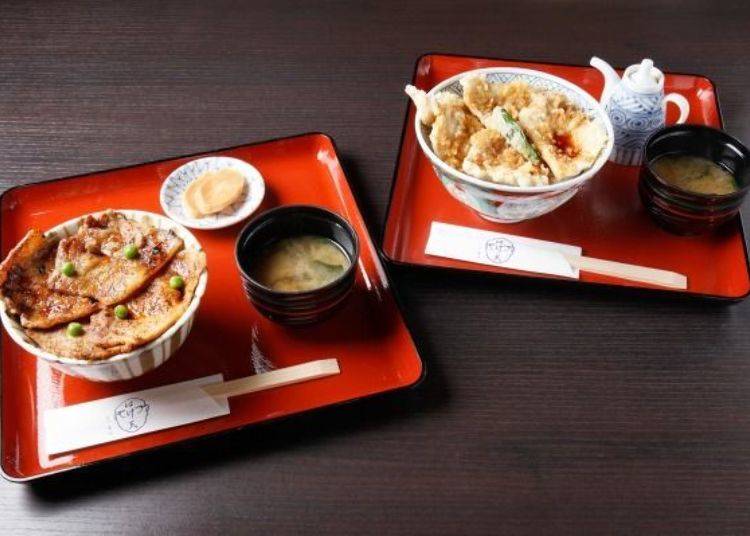
The main branch of Hageten is about a 5-minute walk from JR Obihiro Station. This tempura and kaiseki restaurant also serves the popular “butaten-don.” The pork tempura is light and not greasy. If you visit with a friend, it is recommended that you order both the “Butadon” and Butaten-don” to share.
7. Hokkaido's soul food, “Zangi,” is evolving rapidly

“Zangi,” was first made at Torimatsu, a fried chicken restaurant in Kushiro City, and was an instant hit. The name “zangi” is derived from “zha ji,” the Chinese word for fried chicken.

Traditional Torimatsu zangi is never boneless and is eaten with sauce. The crispy texture is firm enough that it won’t become soggy when dipped in Worcester sauce. In the process of spreading from Torimatsu across Hokkaido, zangi has evolved into a boneless dish and other varies including octopus and oyster have been devised.

“Zantare” is currently attracting attention as an evolution of zangi. A pre-salted form of zangi, it originated at Nambantei, a shop near Kushiro Marsh.
Nambantei’s zantare is a massive portion with 7-8 slices of halved chicken thighs. The sauce is seasoned with soy sauce, sugar, and vinegar, and has a refreshing flavor. If you take a trip across Hokkaido, you’ll be able to sample an exciting variety of zangi!
8. Enjoy the gentle taste of "Ishikari Nabe"
“Ishikari Nabe,” often eaten in homes, is a representative Hokkaido food. This miso-based hot pot made with salmon, trout and a lot of vegetables was traditionally eaten by fishermen.

Ishikari city was a salmon fishing center during the Meiji era, and Kandai-tei, where you can enjoy authentic Ishikari hot pot, opened its doors in 1880.
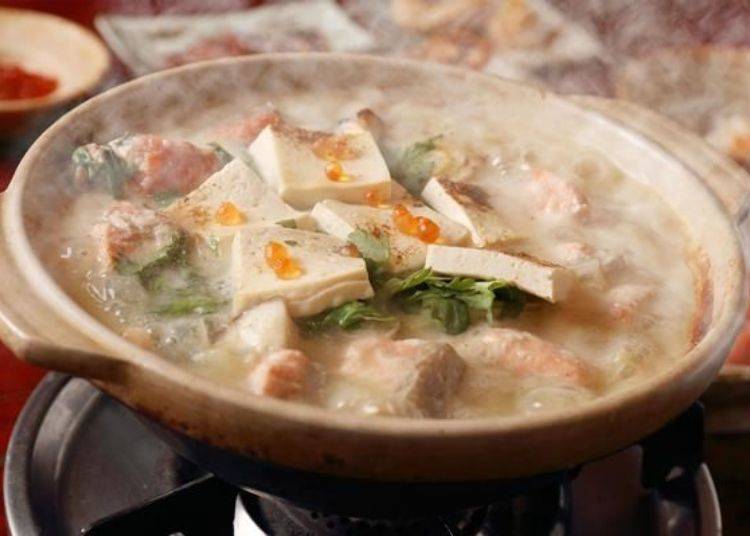
Kindaitei's Ishikari nabe is made of cabbage, onions, ginger, shungiku (crown daisies), long onions, tsukekonnyaku, and salmon roe simmered in a soup of white miso and kelp. Tofu sprinkled with a hint of yam complete the dish and provide a subtle taste.

This traditional Hokkaido food has been handed down for more than 130 years, and, only one hour from Sapporo, Kindaitei is worth visiting. Because the salmon fishing season is autumn and the trout fishing season is spring the dish features salmon from autumn through early spring, and trout from spring through early autumn. While there’s a difference in taste, but you can enjoy delicious Ishikari nabe year-round.
9. Kushiro’s sizeable “Supakatsu”

Attracting attention as a local gourmet in Kushiro City, the “Supakatsu” is recommended for those who love eating. The dish consists of spaghetti, tonkatsu, and meat sauce served on a hot iron plate. First offered more than half a century ago, it has become a standard menu item at many restaurants in Kushiro.

The “Spaghetti Cutlet” was conceived at “Restaurant Izumiya.” Opened in 1959, it was a Western food specialty store, which was a rarity in Kushiro at that time. Supakatsu was designed to make it easy for customers to enjoy an “extravagant” entrée. It immediately became a signature dish, popular for both its taste and generous portion size.

The iron plate ensures that your meal will stay hot to the very end in cold Kushiro, and you’ll hear the appetizing sizzle of the supakatsu as it’s brought to your table. The serving size is about 250 grams of noodles and about 100 grams of tonkatsu, so be sure to eat it on an empty stomach!
10. Exquisite sweets found only in Hokkaido
Hokkaido, known for fresh milk and dairy products, offers a wide array of dairy-based desserts and if you visit Otaru, LeTao can’t be missed.

With stores all over Hokkaido, and now it famous all over the country, LeTao has six different stores in Otaru, each featuring its own distictive sweets.

The “LeTao Main Store,” with its impressive western-style tower, is a truly a shrine for LeTao fans. Here, you can not buy the confectioner’s standard cakes and baked goods, but also a number of in-store exclusives. Among them, the “Deux Fromage Roll” is a cake made by rolling baked cheesecake and cream cheese in a fluffy sponge cake, and is a perfect souvenir.

“Nouvelle Vague Leutao Chocolatier Otaru Main Store,” which is about 3 minutes walk from the main store, is a chocolate specialty shop that sells freshly made chocolate sweets. “Adele,” a dark chocolate mousse layered with two different types of milk chocolate, is an exquisite dish with a rich cocoa scent.

Rokkatei is known for its famous “Marusei Butter Sand,” which is a popular Hokkaido food souvenir. Founded in Obihiro City, Rokkatei offers a wide selection of freshly made Western and Japanese sweets. In addition to the classic sandwich cookies, many products are sold individually or in bulk, making excellent souvenir options.

“Crispy pie,” which is sold only in the Obihiro City store, Obihiro airport store, and Sapporo head office is a rare dessert. The pastry loses its unique crispy texture over time, so it has a shelf life of only 3 hours. Thankfully, the main Obihiro store has an eat-in space where you can enjoy freshly prepared desserts.

Another highly recommended exclusive sweet is the “Marusei Ice Sand.” Inspired by the Marusei Butter Sand, it consists of light biscuits and butter-flavored ice cream. The café on the second floor of the Obihiro store also serves tasty hotcakes and crisp waffles.
On your next trip to Hokkaido, be sure to visit LeTao and Rokkutei for some delicious desserts found only in Hokkaido.
If you really want to experience Hokkaido’s culinary treasure trove, you may need to schedule all three meals a day and a snack at 3pm! So enjoy, and plan to gain 2-3 kilograms!
- Area
- Category
*Prices and options mentioned are subject to change.
*Unless stated otherwise, all prices include tax.
Popular Tours & Activitiess
Recommended places for you
-
Appealing

Rukku and Uohei
Izakaya
Sapporo / Chitose
-
Appealing

Shirogane Blue Pond (Aoiike)
Rivers, Lakes & Canyons
Furano / Biei / Sounkyo
-
Appealing

Shiroi Koibito Park
Theme Parks
Sapporo / Chitose
-
Appealing

Noboribetsu Onsen
Hot Springs (Onsen) & Bath Houses (Sento)
Noboribetsu / Lake Toya
-
Appealing

Mt. Hakodate Observatory
Forests & Mountains
Hakodate
-
Appealing

Sapporo Ramen Yokocho
Ramen
Sapporo / Chitose
-
Ad

Cycling Through Hokkaido: Discover the Beauty of Memuro and the Tokachi Plains
-

Beyond Hakodate and Matsumae: Enjoy the Hidden Gems of Hokkaido’s Donan Area
-
Ad

Smart Ways to Avoid Crowds and Enjoy a Safe, Comfortable Trip to Otaru.
-

BIGGEST SALE ALERT! SATUDORA Tax-Free Winter Sale: Stack Coupons for Massive Savings!
by: Guest Contributor
-

Expert-Recommended: 9 Hakodate Hotels Serving Up the Best Breakfasts in Town
by: Nobuka Kawashima
-
Ad

Smart Ways to Avoid Crowds and Enjoy a Safe, Comfortable Trip to Noboribetsu Onsen
-

Japanese Seaweed: All About 6 of Japan’s Most Popular Varieties!
-

Ultimate Tokyo Transit Guide: JR, Subways, and Private Railways Explained, Plus Suica/PASMO and Money-Saving Passes
-

We Ordered Food at This Susukino Restaurant in Sapporo, But We Weren't Expecting What Happened Next!
-

What are Meibutsu? The Incredible World of Japanese Regional Dishes (Not Just Sushi!)
-

Top 6 Best Restaurants in Kutchan Hokkaido - Where to Eat According to Locals
-

The Best of Japan: 11 Major Cities Every Traveler Should Visit
- #best sushi hokkaido
- #things to do hokkaido
- #best ramen sapporo
- #what to bring to japan
- #new years in tokyo
- #what to buy in ameyoko
- #japanese nail trends
- #what to do in odaiba
- #onsen tattoo friendly tokyo
- #daiso
- #best sweets otaru
- #japanese fashion culture
- #best nature furano
- #japanese convenience store snacks
- #best japanese soft drinks















